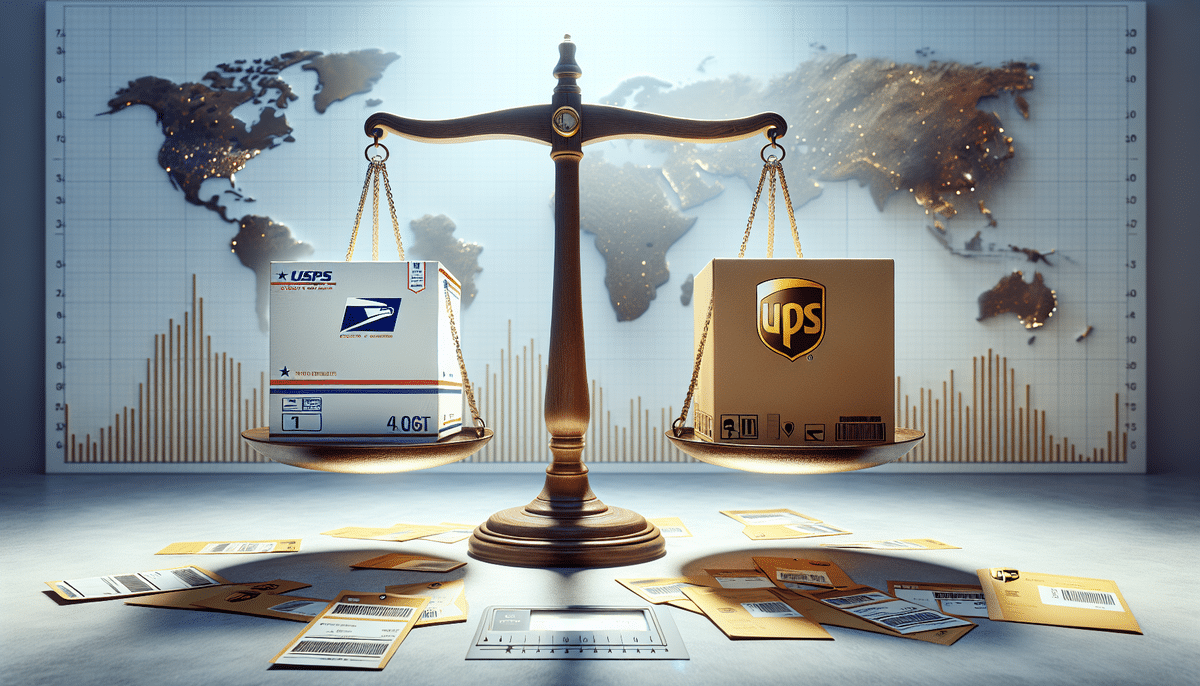Comparing Shipping Rates Between USPS and UPS
When it comes to shipping items for your business, selecting the right carrier is crucial for cost efficiency and customer satisfaction. Two of the most prominent shipping carriers in the United States are the United States Postal Service (USPS) and United Parcel Service (UPS). This article provides a comprehensive comparison of their shipping rates, services, and policies to help you determine which carrier best aligns with your business needs.
Introduction to USPS and UPS Shipping Services
The USPS is a government-owned agency responsible for providing postal services across the United States, including the delivery of letters and packages. USPS offers a variety of shipping options such as First-Class Package Service, Priority Mail, and Priority Mail Express. In contrast, UPS is a global logistics company that provides domestic and international package delivery, freight transportation, and comprehensive logistics management services.
One of the primary differences between USPS and UPS lies in their pricing structures. USPS typically offers more competitive rates for smaller, domestic shipments, while UPS tends to be more economical for larger packages and international shipping. Additionally, USPS boasts an extensive network of post offices and drop-off locations, enhancing convenience for many customers. However, UPS is often favored for its faster and more reliable delivery services, especially for time-sensitive packages.
USPS vs. UPS: Which is Better for Your Business?
Choosing between USPS and UPS requires evaluating several factors, including package size and weight, shipping distance, delivery speed, and overall cost. For small and lightweight items, USPS is generally the more affordable option. Conversely, UPS may be more suitable for heavier items and long-distance or international shipments due to its extensive service offerings.
Tracking and insurance are also critical considerations. While USPS provides basic tracking and insurance options, UPS offers more advanced tracking capabilities and higher insurance coverage for valuable shipments. Additionally, UPS provides various delivery options, such as same-day and weekend delivery, which can be advantageous for businesses with urgent shipping needs. Assessing these factors will enable you to select the carrier that best meets your specific business requirements.
Factors That Affect Shipping Rates
Several elements influence shipping rates, including the type of delivery service selected, delivery distance, package weight, and dimensions. Both USPS and UPS offer multiple shipping options with varying rates, making it essential to research and identify the most cost-effective choice for your business based on these factors.
International shipping rates are also impacted by the destination country, origin, and any applicable customs fees or taxes. These additional costs should be factored into your overall shipping budget to ensure accurate pricing for your customers.
How to Calculate Shipping Costs for USPS and UPS
Both USPS and UPS provide online calculators to estimate shipping costs based on package weight, size, and delivery destination. By entering the required information, you can obtain an estimate of the shipping rate for each carrier.
It's important to note that shipping costs vary depending on the service type selected. For instance, USPS offers Priority Mail, First-Class Mail, and Media Mail, each with different delivery times and pricing structures. Similarly, UPS provides services such as Ground, 2nd Day Air, and Next Day Air. Comparing these options and their associated costs is crucial in determining the most cost-effective shipping method for your business needs.
Comparing the Speed of Delivery Between USPS and UPS
Delivery times can significantly impact customer satisfaction. USPS generally offers faster delivery for smaller packages, whereas UPS may provide quicker delivery options for larger or more complex shipments. Both carriers offer expedited shipping services for those requiring even faster delivery times.
External factors such as weather conditions, holidays, and package destination can also influence delivery times. For example, shipments to remote areas may experience longer transit times compared to deliveries within major metropolitan regions.
In addition to speed, the cost of shipping should be weighed when choosing between USPS and UPS. While USPS might deliver smaller packages faster, UPS may offer more economical rates for bulk or larger shipments. It's advisable to compare both shipping rates and delivery times to make an informed decision.
How to Track Your Shipments with USPS and UPS
Both USPS and UPS provide robust online tracking tools that allow you to monitor the status of your shipments in real-time. By entering the tracking number provided at the time of shipment, you can follow your package's journey until it reaches its destination.
While both carriers offer tracking services, there are differences in the level of detail provided. UPS typically offers more frequent and detailed updates on package locations, whereas USPS might only provide updates at specific points during the delivery process. Additionally, some international shipments may hand off tracking responsibilities to local postal services, resulting in limited tracking information. It's recommended to verify tracking details with your chosen shipping provider.
Differences in Shipping Insurance Policies Between USPS and UPS
Shipping insurance is essential for protecting your shipments against loss or damage. Both USPS and UPS offer insurance options, but their policies differ in terms of coverage and cost.
USPS provides automatic coverage for certain services, with maximum coverage amounts of up to $5,000 for domestic shipments and up to $2,500 for international shipments. On the other hand, UPS allows customers to purchase additional coverage, offering up to $100,000 in coverage for both domestic and international shipments. This higher coverage limit may be crucial for businesses shipping high-value items.
Carefully reviewing and comparing the insurance policies of each carrier will help you determine which option best suits your business's protection needs.
Understanding the Various Shipping Options Available with USPS and UPS
Both USPS and UPS offer a diverse range of shipping options tailored to different business needs. Understanding these options can help you select the most suitable service for your shipments.
Popular USPS shipping options include:
- First-Class Mail: An affordable option for packages weighing up to 13 ounces, ideal for lightweight items.
- Priority Mail: Offers faster delivery times for packages up to 70 pounds, suitable for a wide range of products.
- Priority Mail Express: The fastest USPS option, providing overnight guaranteed delivery to most locations.
UPS provides various shipping services, including:
- Ground: A cost-effective choice for non-urgent shipments, offering reliable delivery within the U.S.
- 2nd Day Air: Ensures delivery within two business days, ideal for time-sensitive shipments.
- Next Day Air: Guarantees next-business-day delivery for urgent shipments.
Additionally, UPS offers supplementary services such as signature confirmation and insurance, providing added security and peace of mind for your shipments.
How to Save Money on Shipping Costs with USPS and UPS
Managing shipping costs effectively can significantly impact your business's bottom line. Here are several strategies to reduce shipping expenses with both USPS and UPS:
- Utilize Online Discounted Rates: Both USPS and UPS offer discounted shipping rates when you purchase and print labels online, eliminating the need for in-store services.
- Purchase and Print Labels in Bulk: Buying shipping labels in bulk can provide additional savings, especially for businesses with high shipping volumes.
- Take Advantage of Free Shipping Supplies: USPS and UPS offer free shipping supplies such as boxes and envelopes, which can help reduce packaging costs.
Another effective method to save on shipping costs is to optimize your package dimensions and weight. Both carriers have specific weight and size restrictions, and exceeding these limits can result in additional fees. Minimizing the size and weight by selecting appropriately sized packaging and removing unnecessary materials can prevent extra charges. Additionally, leveraging USPS's Flat Rate Boxes or UPS's Flat Rate Envelopes provides a fixed price irrespective of weight or distance, offering predictable shipping costs.
Pros and Cons of Using USPS vs. UPS for Online Businesses
Both USPS and UPS offer distinct advantages and disadvantages for online businesses:
- USPS:
- Pros: More cost-effective for small and lightweight packages, extensive network of post offices and drop-off locations.
- Cons: Limited tracking details, potentially slower for larger or bulk shipments.
- UPS:
- Pros: Greater flexibility for larger and heavier packages, advanced tracking options, faster delivery speeds for long-distance shipments.
- Cons: Higher costs for smaller packages, less extensive physical drop-off locations.
Delivery speed is another critical factor. USPS generally provides quicker delivery for local or same-state shipments, while UPS excels in long-distance and nationwide deliveries. Additionally, USPS's widespread network may offer greater convenience for some businesses, whereas UPS's advanced tracking and delivery options like signature confirmation and scheduled deliveries can enhance customer satisfaction.
Real-Life Examples of How Businesses Have Saved Money by Switching Between USPS and UPS
Numerous businesses have successfully optimized their shipping costs by strategically choosing between USPS and UPS based on their specific needs:
For example, a small online retailer specializing in handmade jewelry initially relied solely on UPS for all shipments. Upon analyzing their shipping patterns, they discovered that USPS offered better rates for their smaller packages. By transitioning to USPS for these shipments, the retailer saved over $500 monthly, significantly reducing their operational costs.
In another case, a large e-commerce company shipping thousands of packages daily experienced frequent lost packages and delayed deliveries with USPS. Switching to UPS, despite the higher initial costs, resulted in improved reliability and faster delivery times. This switch not only enhanced customer satisfaction but also reduced the costs associated with lost and delayed packages, leading to long-term savings.
Comparison of International Shipping Rates Between USPS and UPS
International shipping requires careful consideration of rates, delivery times, and service reliability. Both USPS and UPS offer a range of international shipping options:
- USPS: Provides services like First-Class Package International, Priority Mail International, and Priority Mail Express International. These services vary in delivery speed and cost, with Priority Mail Express International offering the fastest delivery times.
- UPS: Offers comprehensive international services including Worldwide Expedited, Worldwide Saver, and Worldwide Express. UPS's services are generally more expensive but provide faster and more reliable delivery compared to USPS.
When comparing international shipping rates, it's essential to consider the destination country's import regulations, customs duties, and taxes. Utilizing tools like the UPS International Shipping Calculator and USPS International Price Calculator can help estimate costs accurately. Additionally, consulting the latest industry reports and government publications can provide updated information on international shipping trends and rates.
Tips for Selecting the Right Carrier for Your Specific Needs
To choose the most suitable carrier for your business, follow these guidelines:
- Evaluate Your Shipping Volume: High-volume shippers may benefit from bulk discounts and negotiated rates offered by carriers like UPS.
- Assess Package Sizes and Weights: Opt for USPS for smaller, lightweight packages and UPS for larger, heavier shipments.
- Consider Delivery Speed Requirements: Use USPS for faster local deliveries and UPS for long-distance or international shipments requiring expedited delivery.
- Review Tracking and Insurance Needs: Choose UPS if advanced tracking and higher insurance coverage are essential for your shipments.
- Analyze Cost Efficiency: Compare the overall cost-effectiveness of each carrier based on your specific shipping patterns and customer expectations.
Conclusion: Which Carrier is Best for Your Business?
Deciding between USPS and UPS depends on your business's unique shipping requirements and priorities. By carefully evaluating factors such as shipping costs, delivery times, insurance options, and available services, you can determine which carrier aligns best with your operational needs. Conducting regular assessments and staying informed about each carrier's evolving services and rates will enable you to make informed decisions, ultimately enhancing your shipping efficiency and customer satisfaction.
For more detailed insights and tools to optimize your shipping strategy, visit ShipScience.




















